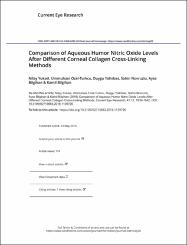Comparison of Aqueous Humor Nitric Oxide Levels After Different Corneal Collagen Cross-Linking Methods

Göster/
Tarih
2016Yazar
Yüksel, NilayÖzel-Türkçü, Ümmühani
Yalınbaş, Duygu
Novruzlu, Şahin
Bilgihan, Ayşe
Bilgihan, Kamil
Üst veri
Tüm öğe kaydını gösterÖzet
Purpose: Nitric oxide production can cause either apoptotic or necrotic cell death through oxidative stress. We aimed to investigate the nitrite oxide metabolites (NOx) and nitrite levels in the aqueous humor of rabbit eyes after different methods of corneal collagen cross-linking (CXL).Materials and methods: Twenty-four eyes of 12 adult New Zealand rabbits were used. They were assigned into four groups, each including six eyes. Group 1 (control) consisted of eyes with no treatment. Group 2 received UV-A power setting at 3 mW/cm(2) for 30 minutes of continuous exposure and named as standard CXL group. Group 3 received UV-A power setting at 30 mW/cm(2) for 3 minutes of continuous exposure and named as accelerated CXL (A-CXL) group. Group 4 received UV-A power setting at 30 mW/cm(2) for 6 minutes of pulsed exposure (1 sec on, 1 sec off) and named as pulse-light accelerated CXL (PLA-CXL). Aqueous humors were aspirated from anterior chamber with a 27G needle after 1 hour UV-A exposure. NOx and nitrite levels were measuredResults: The nitrite levels in aqueous humor were significantly increased in Group 2 and Group 3 when compared with Group 1 (p = 0.000, p = 0.036, respectively). When treatment modalities were compared with each other, high nitrite level in Group 2 was statistically significant when compared with Group 4 (p = 0.019). NOx levels were higher in Group 2 when compared with Group 1 (p = 0.006).Conclusions: Numerous studies investigated the physiological and pathophysiological roles of NO. NO is considered one of the most important molecule for ocular health. According to NOx level in aqueous humor, it seems that PLA-CXL is the safest method due to the similar results with control group.

















